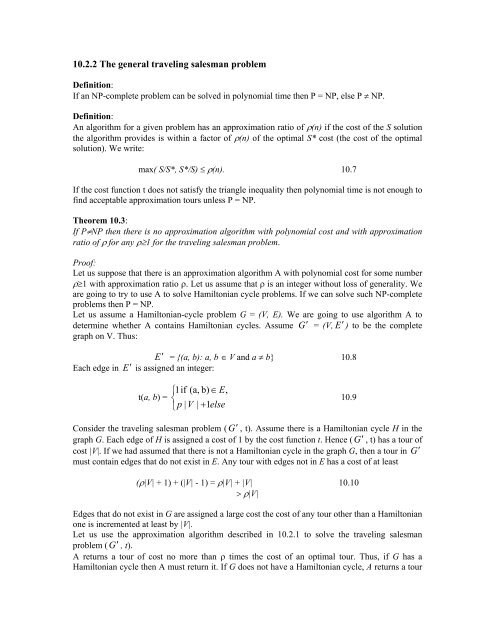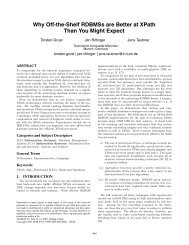Chapter 10 The Traveling Salesman Problem
Chapter 10 The Traveling Salesman Problem
Chapter 10 The Traveling Salesman Problem
Create successful ePaper yourself
Turn your PDF publications into a flip-book with our unique Google optimized e-Paper software.
<strong>10</strong>.2.2 <strong>The</strong> general traveling salesman problem<br />
Definition:<br />
If an NP-complete problem can be solved in polynomial time then P = NP, else P ≠ NP.<br />
Definition:<br />
An algorithm for a given problem has an approximation ratio of ρ(n) if the cost of the S solution<br />
the algorithm provides is within a factor of ρ(n) of the optimal S* cost (the cost of the optimal<br />
solution). We write:<br />
max( S/S*, S*/S) ≤ ρ(n). <strong>10</strong>.7<br />
If the cost function t does not satisfy the triangle inequality then polynomial time is not enough to<br />
find acceptable approximation tours unless P = NP.<br />
<strong>The</strong>orem <strong>10</strong>.3:<br />
If P≠NP then there is no approximation algorithm with polynomial cost and with approximation<br />
ratio of ρ for any ρ≥1 for the traveling salesman problem.<br />
Proof:<br />
Let us suppose that there is an approximation algorithm A with polynomial cost for some number<br />
ρ≥1 with approximation ratio ρ. Let us assume that ρ is an integer without loss of generality. We<br />
are going to try to use A to solve Hamiltonian cycle problems. If we can solve such NP-complete<br />
problems then P = NP.<br />
Let us assume a Hamiltonian-cycle problem G = (V, E). We are going to use algorithm A to<br />
determine whether A contains Hamiltonian cycles. Assume G′ = (V, E′ ) to be the complete<br />
graph on V. Thus:<br />
E′ = {(a, b): a, b ∈ V and a ≠ b} <strong>10</strong>.8<br />
Each edge in E′ is assigned an integer:<br />
⎧1<br />
if (a, b) ∈ E,<br />
t(a, b) = ⎨<br />
<strong>10</strong>.9<br />
⎩ p | V | + 1else<br />
Consider the traveling salesman problem (G′ , t). Assume there is a Hamiltonian cycle H in the<br />
graph G. Each edge of H is assigned a cost of 1 by the cost function t. Hence ( G′ , t) has a tour of<br />
cost |V|. If we had assumed that there is not a Hamiltonian cycle in the graph G, then a tour in G′<br />
must contain edges that do not exist in E. Any tour with edges not in E has a cost of at least<br />
(ρ|V| + 1) + (|V| - 1) = ρ|V| + |V| <strong>10</strong>.<strong>10</strong><br />
> ρ|V|<br />
Edges that do not exist in G are assigned a large cost the cost of any tour other than a Hamiltonian<br />
one is incremented at least by |V|.<br />
Let us use the approximation algorithm described in <strong>10</strong>.2.1 to solve the traveling salesman<br />
problem (G ′ , t).<br />
A returns a tour of cost no more than ρ times the cost of an optimal tour. Thus, if G has a<br />
Hamiltonian cycle then A must return it. If G does not have a Hamiltonian cycle, A returns a tour






